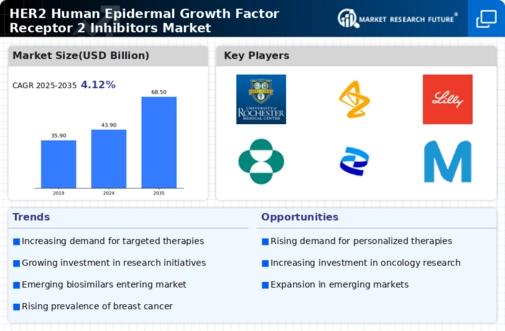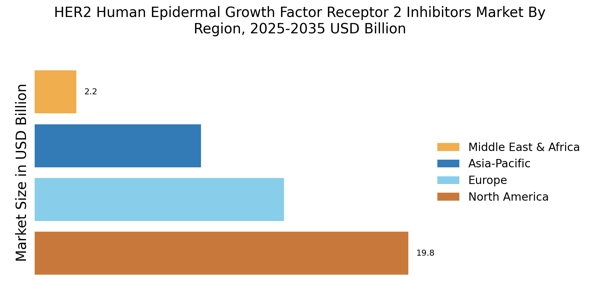Advancements in Targeted Therapies
Advancements in targeted therapies are significantly influencing the HER2 Human Epidermal Growth Factor Receptor 2 Inhibitors Market. The development of novel HER2 inhibitors, such as trastuzumab and neratinib, has revolutionized treatment protocols for HER2 positive cancers. These therapies are designed to specifically target the HER2 receptor, leading to improved patient outcomes and reduced side effects compared to traditional chemotherapy. The market is projected to grow as new therapies enter the pipeline, with several candidates currently undergoing clinical trials. The introduction of biosimilars is also expected to enhance market competition, potentially lowering costs and increasing accessibility for patients. As the landscape of cancer treatment continues to evolve, the HER2 Human Epidermal Growth Factor Receptor 2 Inhibitors Market is likely to expand, driven by these innovative therapeutic options.
Growing Investment in Cancer Research
The growing investment in cancer research is a crucial driver for the HER2 Human Epidermal Growth Factor Receptor 2 Inhibitors Market. Governments and private organizations are increasingly allocating funds to research initiatives aimed at understanding and treating HER2 positive cancers. This influx of capital supports the development of new therapies and enhances clinical trial opportunities, which are essential for bringing innovative HER2 inhibitors to market. According to recent data, funding for cancer research has seen a significant uptick, with billions of dollars being invested annually. This trend is expected to continue, fostering an environment conducive to breakthroughs in HER2 targeted therapies. As research progresses, the HER2 Human Epidermal Growth Factor Receptor 2 Inhibitors Market is poised for growth, driven by the continuous quest for more effective treatment options.
Rising Awareness and Screening Programs
Rising awareness and screening programs for breast cancer are pivotal in driving the HER2 Human Epidermal Growth Factor Receptor 2 Inhibitors Market. Increased public awareness campaigns and educational initiatives have led to higher screening rates, resulting in earlier detection of HER2 positive cancers. This proactive approach not only improves patient outcomes but also expands the market for HER2 inhibitors, as more patients are diagnosed and treated. Additionally, healthcare providers are increasingly recommending genetic testing to identify HER2 positive patients, further fueling the demand for targeted therapies. As awareness continues to grow, the HER2 Human Epidermal Growth Factor Receptor 2 Inhibitors Market is likely to experience sustained growth, reflecting the importance of early detection and intervention in cancer treatment.
Regulatory Support for Innovative Therapies
Regulatory support for innovative therapies is a significant driver of the HER2 Human Epidermal Growth Factor Receptor 2 Inhibitors Market. Regulatory agencies are increasingly prioritizing the approval of targeted therapies, recognizing their potential to improve patient outcomes. Fast-track designations and priority review processes for HER2 inhibitors have accelerated their entry into the market, allowing patients to access these therapies sooner. This supportive regulatory environment encourages pharmaceutical companies to invest in the development of new HER2 inhibitors, knowing that there is a pathway for expedited approval. As more innovative therapies gain regulatory approval, the HER2 Human Epidermal Growth Factor Receptor 2 Inhibitors Market is expected to flourish, driven by the availability of cutting-edge treatment options.
Increasing Incidence of HER2 Positive Cancers
The rising incidence of HER2 positive cancers, particularly breast cancer, is a primary driver for the HER2 Human Epidermal Growth Factor Receptor 2 Inhibitors Market. Statistics indicate that approximately 20 to 25% of breast cancer cases are HER2 positive, necessitating targeted therapies. This growing patient population is likely to propel demand for HER2 inhibitors, as they are specifically designed to target and inhibit the HER2 receptor. Furthermore, the increasing awareness and early detection of breast cancer contribute to the rising number of diagnosed cases, thereby expanding the market for HER2 inhibitors. As treatment options evolve, the HER2 Human Epidermal Growth Factor Receptor 2 Inhibitors Market is expected to witness substantial growth, driven by the need for effective therapies that cater to this specific subset of cancer patients.


















Leave a Comment